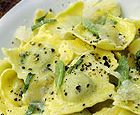|
Italian Entree
Ravioli
Turtei or Tortelli
(Serves 4)
Recipe submitted by James Vescovi: “Turtei means tortelli or ravioli in the dialect of my grandparents, who grew in peasant families in northern Italy. The biggest town in the area was Berceto, known for its ninth century cathedral, which sits along Via Francigena, an ancient Roman road. My grandparents' story is told in my book Eat Now; Talk Later."
Mixed fresh greens (e.g., Swiss chard, spinach, beet tops)
2 medium shallots (thinly sliced)
6 T butter or olive oil (divided)
6 eggs
1/4 C chopped herbs (parsley and/or basil)
1/2 C soft cheese (ricotta or mascarpone)*
1 C grated Parmigiano-Reggiano (divided)
salt & pepper to taste
3 C flour
4 small bay leaves (torn into bits)
Filling:
• Tear leaves from stems and wash.
• Heat 1 T oil (or butter) in a skillet. Add shallots and cook till soft (3-5 minutes.) Remove shallots and set aside.
• Heat another T of oil in the skillet, add greens, still dripping with rinse water—the water will steam them. Cook 8 to 10 minutes.
• Drain using cold water to retain color and squeeze out excess water.
• Chop into 1"-wide ribbons.
• Add greens to large bowl. Stir in 1 egg, soft cheese, 1/2 C grated cheese, herbs, salt & pepper.
• Set aside.
Dough
• Mound the flour onto a working surface.
• Make a well in the center of the mound by pressing the bottom of a small bowl into top.
• Break 4 eggs into well, and with a fork quickly scrape flour from inside the well onto eggs, little by little. Once eggs are absorbed by surrounding flour, push the remaining flour mound into the egg mix.
• Knead for 10 minutes—adding more flour if dough feels tacky. Continue kneading until dough is smooth and elastic.
• Wrap in plastic and let rest for 30 minutes.
Assemble:
• After 30 minutes, divide dough into 2 balls and place on floured surface.
• Roll each ball—working from the center outwards, turn dough clockwise, keep pressing from center outwards, keep turning and rolling until you're tired. Your second ball is, of course, covered and waiting in the wings.
• Slice one sheet of dough into strips. Some edges will be rounded, but don’t worry about this. The universe takes care of it.
• Add several dollops of filling—approx. 1 T—to each strip, leaving 1" between each spoonful and 1/2" at the edges.
• Beat yolk of 1 egg with a few drops of water and brush dough surrounding each bit of filling.
• Place the second sheet of dough on top of the first, pressing your fingers around the filling to seal the "pillows." Cut them apart with a sharp knife or pastry cutter and press edges together.
• Move ravioli to a floured surface to rest for 60 minutes.
Cook
• Bring large pot of lightly salted water to boil.
• Drop ravioli into pot for 3-4 minutes (don't overcook).
• Drain
Serve
• Melt 4 T butter or oil with torn sage leaves.
• Pour butter/sage mix into serving bowl, add ravioli, tossing to coat.
• Sprinkle with grated cheese—and serve.
* You can use cream cheese, adding a sprinkle of salt to tone down the sweetness.
| See more Italian recipes |
|
|
Tips & Glossary
Arborio Rice: a medium-grained rice. Its high starch content yields a creamy texture and is the basis for risotto.
Balsamic Vinegar: dark, thick vinegar with a sweet pungent flavor. Fermented, concentrated, and aged in wooden casks, sometimes up to 12 years. Can be pricey.
Caper: salty, pickled bud of spiny shrub native to the Mediterranean region. Most prized is the non-pareil, the smallest (approx. 1/8”), though other sizes are tasty and less expensive.
Formaggio: Cheese! Like France, Italy is a land of sublime cheeses, some 400 varieties. Here are some of the most widely sold in the U.S.
• Asiago (Alpine region; smooth or crumbly, great for grating.)
• Fontina (Alpine region; a Gruyere- or Swiss-type cheese with nutty flavor.)
• Mascarpone (southwest of
Milan; triple-cream, smooth and easily spread; used in Tiramisu.)
• Mozzarella (generic term for semi-soft cheese; “fresh” is eaten the day it is made; “buffalo” is from water buffalo. Used in lasagna and pizza when dried slightly.)
• Parmigiano Reggiano (Parma area; the true Parmesan, whose designation is strictly controlled in Italy.)
• Pecorino Romano (made of sheep’s milk; mostly from Sardinia. A hard, salty cheese used for grating.)
• Provolone (mostly from northern Italy; semi-hard, varying from mild to sharp flavor.)
• Ricotta (made of whey, a by-product of making other cheese; soft and creamy like cottage cheese. Used in lasagna.)
• Romano (an American term for Pecorino Romano and other cheeses.)
Italian Seasoning: blend of dried herbs used in Italian cooking—marjoram, thyme, rosemary, savory, sage, oregano, and basil. Packaged commercially and found in most food stores. You can also make your own.
Olive Oil: There's much more to know than is room for here. To learn all you need to know about the different grades of oil, and much, much more, head to Tanbourit.
Pine Nuts: pinoli or pignoli; edible seeds of pine trees used in pesto sauce. Before cooking, release flavor by lightly browning in a heated skillet.
Plum Tomatoes: aka Italian tomatoes; oval-shaped. Used in sauces because they are meatier with fewer seeds than standard tomatoes.
Roasted peppers: buy or make your own: place under a broiler, or hold over a gas flame, till skin chars and blisters. Place in a closed paper bag for 15-20 minutes (to steam them). When cool, the skins slip off under water.
Prosciutto: especially Prosciutto di Parma, dry-cured ham from Parma. The real deal! Cured up to 2 years, is almost sweet and very expensive. You can substitute with capicola, a delicious, light peppery ham.
-
|

